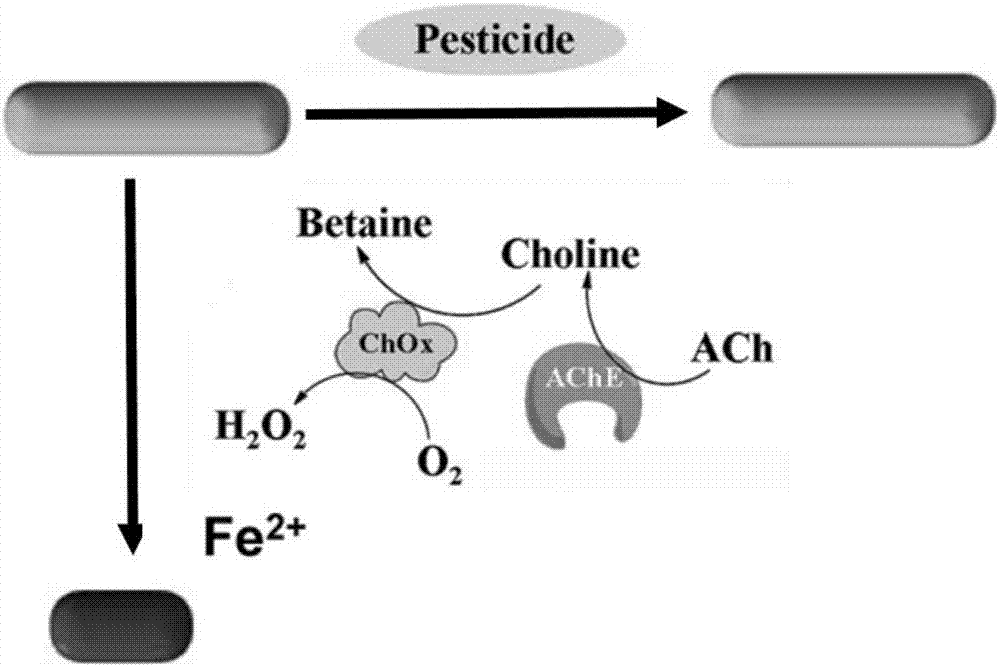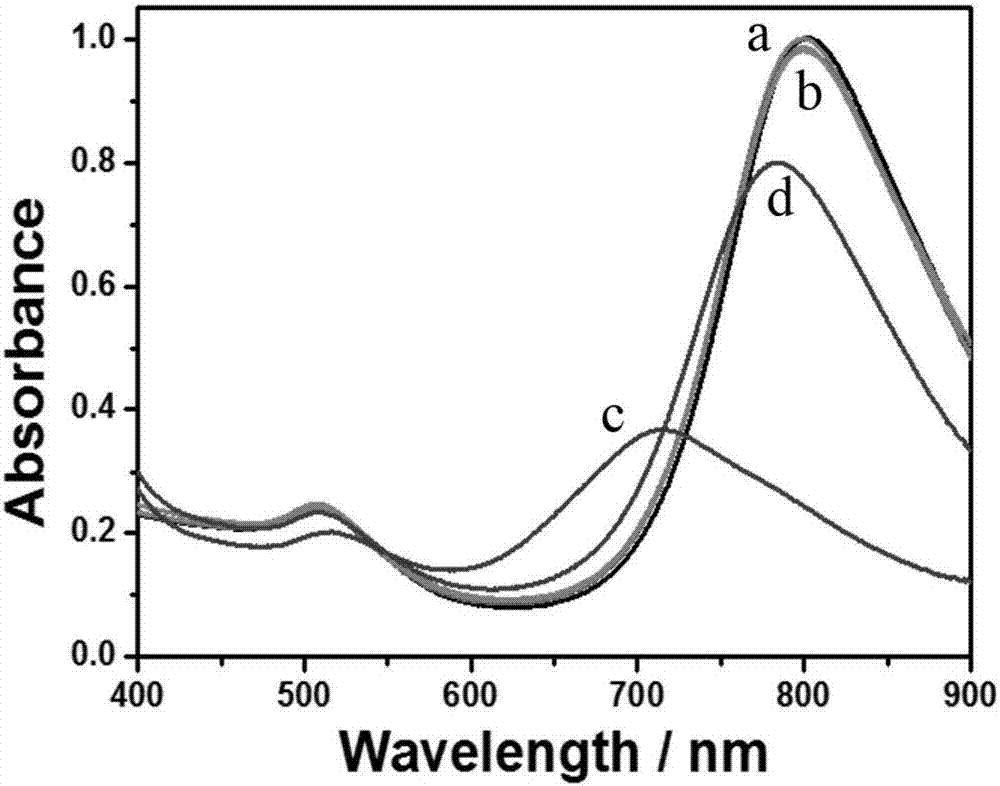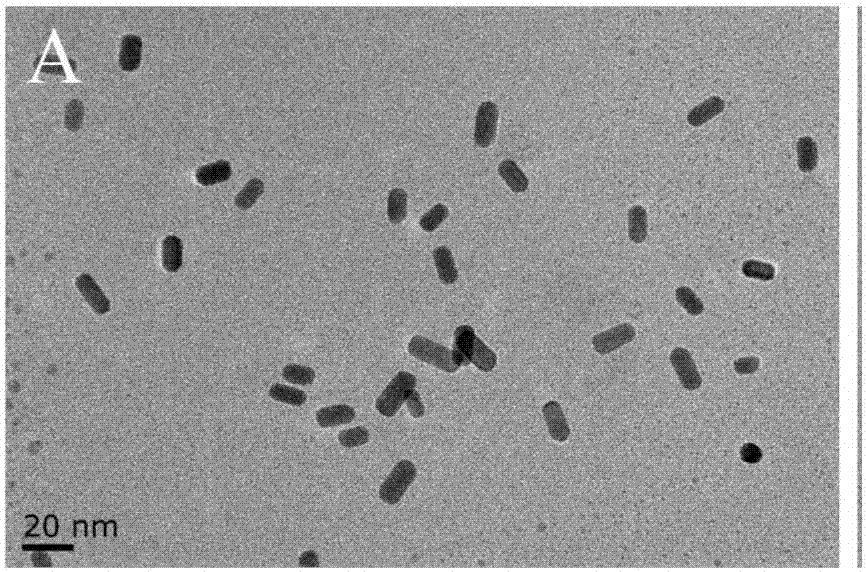Method of quantitatively detecting organophosphorus pesticide by constructing colorimetric sensor based on gold nanorod etching
An organophosphorus pesticide and colorimetric sensor technology, applied in the field of biosensing, can solve problems such as increase, and achieve the effects of low cost, rich variety and convenient operation.
- Summary
- Abstract
- Description
- Claims
- Application Information
AI Technical Summary
Problems solved by technology
Method used
Image
Examples
Embodiment 1
[0040] A method for quantitatively detecting organophosphorus pesticides by constructing a colorimetric sensor based on gold nanorod etching, the detection steps are:
[0041] Steps for one-pot synthesis of gold nanorods: first, soak glass instruments such as beakers used in the experiment with aqua regia (hydrochloric acid: nitric acid = 3:1) for 24 hours. Then, to prepare the gold nanorod growth solution, 1520 μL of chloroauric acid (10 mmol / L), 222 μL of silver nitrate (20 mmol / L) and 1 mL of hydroquinone (5.26 mmol / L) were sequentially added to 34.612 mL of CTAB, and gently Shake and stand for 5 minutes, finally add 646 μL of sodium borohydride (1 mmol / L) and let stand for 12 hours. All experimental operations are carried out at 30°C. Then the resulting solution was centrifuged at 15,000×g for 20 minutes, redissolved in 40 mL of ultrapure water after centrifugation twice, and stored in a brown bottle at room temperature.
[0042] Acetylcholinesterase detection steps: Take...
Embodiment 2
[0047] A method for quantitatively detecting organophosphorus pesticides by constructing a colorimetric sensor based on gold nanorod etching, the detection steps are:
[0048] Steps for one-pot synthesis of gold nanorods: first, soak glass instruments such as beakers used in the experiment with aqua regia (hydrochloric acid: nitric acid = 3:1) for 24 hours. Then, to prepare the gold nanorod growth solution, 1520 μL of chloroauric acid (10 mmol / L), 222 μL of silver nitrate (20 mmol / L) and 1 mL of hydroquinone (5.26 mmol / L) were sequentially added to 34.612 mL of CTAB, and gently Shake and stand for 5 minutes, finally add 646 μL of sodium borohydride (1 mmol / L) and let stand for 12 hours. All experimental operations are carried out at 30°C. Then the obtained solution was centrifuged at 15000×g for 20 minutes, redissolved in ultrapure water after centrifugation twice, and stored in a brown bottle at room temperature.
[0049] Acetylcholinesterase detection steps: Take an EP tube...
Embodiment 3
[0054] A method for quantitatively detecting organophosphorus pesticides by constructing a colorimetric sensor based on gold nanorod etching, the detection steps are:
[0055] Steps for one-pot synthesis of gold nanorods: first, soak glass instruments such as beakers used in the experiment with aqua regia (hydrochloric acid: nitric acid = 3:1) for 24 hours. Then, to prepare the gold nanorod growth solution, 1520 μL of chloroauric acid (10 mmol / L), 222 μL of silver nitrate (20 mmol / L) and 1 mL of hydroquinone (5.26 mmol / L) were sequentially added to 34.612 mL of CTAB, and gently Shake and stand for 5 minutes, finally add 646 μL of sodium borohydride (1 mmol / L) and let stand for 12 hours. All experimental operations are carried out at 30°C. Then the obtained solution was centrifuged at 15000×g for 20 minutes, redissolved in ultrapure water after centrifugation twice, and stored in a brown bottle at room temperature.
[0056] Acetylcholinesterase detection steps: Take an EP tube...
PUM
 Login to View More
Login to View More Abstract
Description
Claims
Application Information
 Login to View More
Login to View More - R&D
- Intellectual Property
- Life Sciences
- Materials
- Tech Scout
- Unparalleled Data Quality
- Higher Quality Content
- 60% Fewer Hallucinations
Browse by: Latest US Patents, China's latest patents, Technical Efficacy Thesaurus, Application Domain, Technology Topic, Popular Technical Reports.
© 2025 PatSnap. All rights reserved.Legal|Privacy policy|Modern Slavery Act Transparency Statement|Sitemap|About US| Contact US: help@patsnap.com



